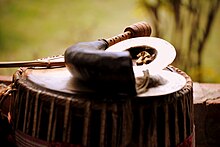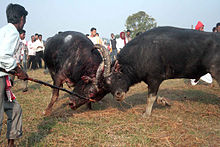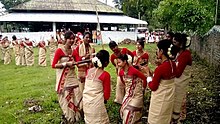Bihu
| Bihu | |
|---|---|
 Bihu of Assam | |
| Official name | Bihu |
| Also called | Rongali Bihu (April) • Kaati Bihu (October) • Bhogali Bihu (January) |
| Observed by | Assamese people |
| Type | Regional folk |
| Ends | Varies |
| Date | In the months of Bohag, Kaati and Maagh |
| Frequency | Tri-annual |
| Part of a series on the |
| Culture of Assam |
|---|
 |
|
Protohistoric
Ancient Medieval Colonial |
|
|
|
|
Festivals
|
|
History
Archives
Genres Institutions Awards Asam Sahitya Sabha Award • Kamal Kumari Foundation Award • Krishnakanta Handique Award |
|
Music and performing arts |
Bihu is the chief festival in the Assam state of India. It refers to a set of three different festivals: Rongali or Bohag Bihu observed in April, Kongali or Kati Bihu observed in October, and Bhogali or Magh Bihu observed in January.[1] The Rongali Bihu is the most important of the three, celebrating the Assamese new year and the spring festival. The Bhogali Bihu or the Magh Bihu is the one that is all about food. The Kongali Bihu or the Kati Bihu is the sombre, thrifty one reflecting a season of short supplies and is an animistic festival.[2]
The Rongali Bihu coincides with the Indian new year with festivals like Baisakhi, Bishu, etc as well as with Tai harvest festivals like Poi-Sangken festival in Thailand and other regions of East and South-East Asia which follow the Buddhist calendar.[3] The other two Bihu festivals every year are unique to Assamese people. Like some other Indian festivals, Bihu is associated with agriculture, and rice in particular. Bohag Bihu is a sowing festival, Kati Bihu is associated with crop protection and worship of plants and crops and is an animistic form of the festival, while Bhogali Bihu is a harvest festival.[4][5] Assamese celebrate the Rangali Bihu with feasts, music and dancing. Some hang brass, copper or silver pots on poles in front of their house, while children wear flower garlands then greet the new year as they pass through the rural streets.[6]
The three Bihu are Assamese festivals with reverence for Krishna, cattle (Goru Bihu),[6] elders in family, fertility and mother goddess, but the celebrations and rituals reflect influences from aborigine, southeast Asia and Sino-Tibetan cultures.[7][8][9] In contemporary times, the Bihus are celebrated by all Assamese people irrespective of religion, caste or creed.[10] It is also celebrated overseas by the Assamese diaspora community living worldwide.
The term Bihu is also used to imply Bihu dance otherwise called Bihu Naas and Bihu folk songs also called Bihu Geet.
Contents
History[edit]
According to Hakacham, the first form of modern Bihu dance was developed in a temple now known as Harhi Dewaloi. Later, in the 19th century, this form of Bihu dance was adopted by the other communities as well and started being performed in Mahguli sapori, Dhakuakhana by Tai-Ahom , Chutias, Sonowals, Deoris,, Mishing, etc.[11]
The three Bihu Festivals[edit]
Bohag Bihu[edit]
Bohag Bihu (বহাগ বিহু)(mid-April, also called Rongali Bihu), the most popular Bihu celebrates the onset of the Assamese New Year (around 14–15 April) and the coming of Spring. This marks the first day of the Hindu solar calendar and is also observed in Bengal, Manipur, Mithila, Nepal, Orissa, Punjab, Kerala and Tamil Nadu though called by different names. It's a time of merriment and feasting and continues, in general, for seven days. The farmers prepare the fields for cultivation of paddy and there is a feeling of joy around. The women make pitha, larus (traditional food made of rice, coconut) various drinks by local tribes such as Nam-Lao by Tai-Ahom, Aapong by Mising tribe and Jolpan which gives the real essence of the season.
The first day of the bihu is called goru bihu or cow bihu, where the cows are washed and worshipped, which falls on the last day of the previous year, usually on 14 April. This is followed by manuh (human) bihu on 15 April, the New Year Day. This is the day of getting cleaned up, wearing new cloths and celebrating and getting ready for the new year with fresh vigor. The third day is Gosai (Gods) bihu; statues of Gods, worshiped in all households are cleaned and worshiped asking for a smooth new year.
The folk songs associated with the Bohag Bihu are called Bihugeets or Bihu songs. The form of celebration and rites vary among different demographic groups.
Rongali Bihu is also a fertility festival, where the bihu dance with its sensuous movements using the hips, arms, etc., by the young women call out to celebrate their fertility.
The Seven days[edit]
Bohag Bihu or Rongali Bihu festival continues for seven days and called as Xaat Bihu. The seven days are known as Chot Bihu, Goru Bihu, Manuh Bihu, Kutum Bihu, Senehi Bihu, Mela Bihu and Chera Bihu.
Kati Bihu[edit]

Kongali Bihu (mid-October, also called Kati-Bihu) has a different flavor as there is less merriment and the atmosphere has a sense of constraining and solemnity. During this time of the year, the paddy in the fields are in the growing stage and the granaries of the farmers are almost empty. On this day, earthen lamps (saki) are lit at the foot of the household tulsi plant, the granary, the garden (bari) and the paddy fields. To protect the maturing paddy, cultivators whirl a piece of bamboo and recite rowa-khowa chants and spells to ward off pests and the evil eye. During the evening, cattle are fed specially made rice items called pitha. The Bodo people light lamps at the foot of the siju (Euphorbia neriifolia) tree. This Bihu is also associated with the lighting of akaxi gonga or akaxbonti, lamps at the tip of a tall bamboo pole, to show the souls of the dead the way to heaven, a practice that is common to many communities in India, as well as Asia and Europe.[12]
Bhogali Bihu[edit]
Bhogali Bihu (mid-January, also called Magh Bihu) comes from the word Bhog that is eating and enjoyment.[13] It is a harvest festival and marks the end of harvesting season. Since the granaries are full, there is a lot of feasting and eating during this period. On the eve of the day called uruka, i.e., the last day of pausa, menfolk, more particularly young men go to the field, preferably near a river, build a makeshift cottage called Bhelaghar with the hay of the harvest fields and the bonfire or Meji, which is may derived from the Tai-Ahom festival Poy-Me-jii which means worshipping bhoral or storehouse [ME=WORSHIP,JII=STOREHOUSE]. the most important thing for the night. During the night, they prepare food and there is community feasting everywhere. There is also the exchange of sweets and greetings at this time. The entire night (called Uruka) is spent around a Meji with people singing bihu songs, beating Dhol, a typical kind of drums or playing games. Boys roam about in the dark stealing firewood and vegetables for fun. The next morning they take a bath and burn the main Meji. People gather around the Meji and throw Pithas (rice cakes) and betel nuts to it while burning it at the same time. They offer their prayers to the god of Fire and mark the end of the harvesting year. Thereafter they come back home carrying pieces of half burnt firewood for being thrown among fruit trees for favorable results. All the trees in the compound are tied to bamboo strips or paddy stems. Different types of sports like Buffalo-fight, Egg-fight, Cock-fight, Nightingale-fight etc. are held throughout the day. There are other conventional festivals observed by various ethnic-cultural groups. Me-dam-me-phi, Ali-aye-ligang, Porag, Garja, Hapsa Hatarnai, Kherai are few among them. The koch celebrates this bihu as pushna.[14]
Instruments used in Bihu[edit]
Bihu elsewhere[edit]
Bihu is also seen to be celebrated abroad. Many Bihu associations/committees exist elsewhere where this festival is celebrated with enthusiasm. The London Bihu Committee (LBC), UK is one of them among others.
Related festivals[edit]
The Bohag Bihu (Rongali Bihu) festive day is celebrated elsewhere but called by other name.[15][16][17] Some examples of related festivals in Asia include:
- Songkran festival in Burma, Thailand and other festivals of East Asia and South-East Asia
- Bikram Samwat / Vaishak Ek in Nepal
- Sinhalese New Year in Sri Lanka.[18]
However, this is not the universal new year for all Hindus. For some, such as those in and near Gujarat, the new year festivities coincide with the five day Diwali festival. For others, the new year falls on Ugadi and Gudi Padwa, which falls about two weeks before Bohag Bihu.Thus, Bohag Bihu is the New Year festival of the Indigenous Assamese people.[17]
Southeast Asia[edit]
The same day every year is also the new year for many Buddhist communities in parts of East Asia and Southeast Asia such as Myanmar, Sri Lanka, Cambodia, Yunnan in China, Vietnam and Thailand likely an influence of their shared culture in the 1st millennium CE.[17]
According to Jean Michaud and other scholars, the new year celebration traditions in Southeast Asian Massif have two roots.[19] One is China, and this influence is found for example in Vietnam and southeastern China. These Sino-influenced communities celebrate the new year in the first or second lunar month after the winter solstice in December. The second group of people in the Massif celebrate the new year in mid-April, much like most of India. This group consists of northeastern Indians, northeastern Myanmar, Tai speakers of Thailand, Laos, northern Vietnam and southern Yunnan.[19] The festival celebrated in Burma, Thailand, Laos, Vietnam, Yunnan in China is celebrated in the Massif in ways like Bihu celebrated by Indigenous people of Assam and other Northeast Indian states. It is marked by an occasion to visit family and friends, splashing others with water, drinking alcohol, as well as later wearing jewelry, new clothes and socializing.[19] The new year festival is called regionally by different names:
See also[edit]
Notes and references[edit]
- ^ Roshen Dalal (2010). Hinduism: An Alphabetical Guide. Penguin Books. p. 136. ISBN 978-0-14-341421-6.
- ^ Sunita Pant Bansal (2005). Encyclopaedia of India. Smriti Books. p. 67. ISBN 978-81-87967-71-2.
- ^ Praphulladatta Goswami (1966). The springtime bihu of Assam: a socio-cultural study. Gauhati. OCLC 474819.
- ^ S. D. Sharma (2010). Rice: Origin, Antiquity and History. CRC Press. pp. 56, 60–61. ISBN 978-1-4398-4056-6.
- ^ Goswami, Praphulladatta (1967). "Hindu and Tribal Folklore in Assam". Asian Folklore Studies. JSTOR. 26 (1): 19. doi:10.2307/1177697.
- ^ a b Christian Roy (2005). Traditional Festivals: A Multicultural Encyclopedia. ABC-CLIO. pp. 479–480. ISBN 978-1-57607-089-5.
- ^ Roshen Dalal (2010). Hinduism: An Alphabetical Guide. Penguin Books. p. 76. ISBN 978-0-14-341421-6.
- ^ Uddipana Goswami (2014). Conflict and Reconciliation: The Politics of Ethnicity in Assam. Routledge. pp. 61–63. ISBN 978-1-317-55997-9.
- ^ Amaresh Datta (1988). Encyclopaedia of Indian Literature. Sahitya Akademi. pp. 1277–1278. ISBN 978-81-260-1194-0.
- ^ Culture of Assam - Government Of Assam, India
- ^ Hakacham, Upen Rabha (2010). Origin of Bihu. Guwahati.
- ^ Goswami 1988, pp7-8
- ^ Celebrating Nature's Bounty - Magh Bihu Archived 2012-01-17 at the Wayback Machine, Efi-news.com
- ^ Sankalp India Foundation. "Bihu: A celebration of Assamese culture | Sankalp India Foundation". Sankalpindia.net. Retrieved 2012-12-19.
- ^ Lau, Vishaal (14 July 2007). "Religions - Hinduism: Vaisakhi". BBC. Retrieved 19 July 2018.
- ^ Crump, William D. (2014), Encyclopedia of New Year's Holidays Worldwide, MacFarland, page 114
- ^ a b c Karen Pechilis; Selva J. Raj (2013). South Asian Religions: Tradition and Today. Routledge. pp. 48–49. ISBN 978-0-415-44851-2.
- ^ Peter Reeves (2014). The Encyclopedia of the Sri Lankan Diaspora. Didier Millet. p. 174. ISBN 978-981-4260-83-1.
- ^ a b c Jean Michaud; Margaret Byrne Swain; Meenaxi Barkataki-Ruscheweyh (2016). Historical Dictionary of the Peoples of the Southeast Asian Massif. Rowman & Littlefield. p. 284. ISBN 978-1-4422-7279-8.
- Das, Debendra Prasad Rongali Bihu through the ages, The Assam Tribune, 14 April 2007.
- Dowerah, Sawpon Rongali Bihu-the spring festival of Assam, The Assam Tribune, 14 April 2007.
- Goswami, Prafulladatta (1988) Bohag Bihu of Assam and Bihu songs, Publication Board, Assam.
External links[edit]
| Wikimedia Commons has media related to Bihu dance. |










